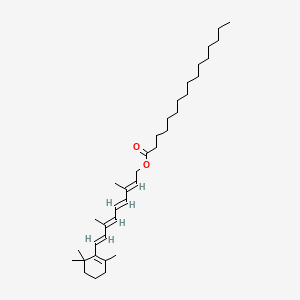| MeSH term | MeSH ID | Detail |
|---|---|---|
| Edema | D004487 | 152 associated lipids |
| Weight Gain | D015430 | 101 associated lipids |
| Cell Transformation, Neoplastic | D002471 | 126 associated lipids |
all-trans-retinyl Palmitate
All-trans-retinyl palmitate is a lipid of Prenol Lipids (PR) class. All-trans-retinyl palmitate is associated with abnormalities such as Wiskott-Aldrich Syndrome.
Cross Reference
Introduction
To understand associated biological information of all-trans-retinyl Palmitate, we collected biological information of abnormalities, associated pathways, cellular/molecular locations, biological functions, related genes/proteins, lipids and common seen animal/experimental models with organized paragraphs from literatures.
What diseases are associated with all-trans-retinyl Palmitate?
all-trans-retinyl Palmitate is suspected in and other diseases in descending order of the highest number of associated sentences.
Related references are mostly published in these journals:
| Disease | Cross reference | Weighted score | Related literature |
|---|
Possible diseases from mapped MeSH terms on references
We collected disease MeSH terms mapped to the references associated with all-trans-retinyl Palmitate
PubChem Associated disorders and diseases
What pathways are associated with all-trans-retinyl Palmitate
There are no associated biomedical information in the current reference collection.
PubChem Biomolecular Interactions and Pathways
Link to PubChem Biomolecular Interactions and PathwaysWhat cellular locations are associated with all-trans-retinyl Palmitate?
There are no associated biomedical information in the current reference collection.
What functions are associated with all-trans-retinyl Palmitate?
There are no associated biomedical information in the current reference collection.
What lipids are associated with all-trans-retinyl Palmitate?
There are no associated biomedical information in the current reference collection.
What genes are associated with all-trans-retinyl Palmitate?
There are no associated biomedical information in the current reference collection.
What common seen animal models are associated with all-trans-retinyl Palmitate?
There are no associated biomedical information in the current reference collection.
NCBI Entrez Crosslinks
All references with all-trans-retinyl Palmitate
Download all related citations| Authors | Title | Published | Journal | PubMed Link |
|---|---|---|---|---|
| Coutsoudis A et al. | Randomized trial testing the effect of vitamin A supplementation on pregnancy outcomes and early mother-to-child HIV-1 transmission in Durban, South Africa. South African Vitamin A Study Group. | 1999 | AIDS | pmid:10465076 |
| Liu C et al. | Chlormethiazole treatment prevents reduced hepatic vitamin A levels in ethanol-fed rats. | 2002 | Alcohol. Clin. Exp. Res. | pmid:12436060 |
| Jeppesen J et al. | Effect of variations in oral fat and carbohydrate load on postprandial lipemia. | 1995 | Am. J. Clin. Nutr. | pmid:7491880 |
| Dougherty KA et al. | No improvement in suboptimal vitamin A status with a randomized, double-blind, placebo-controlled trial of vitamin A supplementation in children with sickle cell disease. | 2012 | Am. J. Clin. Nutr. | pmid:22952182 |
| Pirie A and Anbunathan P | Early serum changes in severely malnourished children with corneal xerophthalmia after injection of water-miscible vitamin A. | 1981 | Am. J. Clin. Nutr. | pmid:7192488 |
| Viteri FE et al. | Fortification of sugar with iron sodium ethylenediaminotetraacetate (FeNaEDTA) improves iron status in semirural Guatemalan populations. | 1995 | Am. J. Clin. Nutr. | pmid:7733042 |
| Westphal S et al. | Postprandial chylomicrons and VLDLs in severe hypertriacylglycerolemia are lowered more effectively than are chylomicron remnants after treatment with n-3 fatty acids. | 2000 | Am. J. Clin. Nutr. | pmid:10731497 |
| Gadomski AM et al. | Conjunctival impression cytology (CIC) to detect subclinical vitamin A deficiency: comparison of CIC with biochemical assessments. | 1989 | Am. J. Clin. Nutr. | pmid:2646902 |
| van Vliet T et al. | Intestinal beta-carotene absorption and cleavage in men: response of beta-carotene and retinyl esters in the triglyceride-rich lipoprotein fraction after a single oral dose of beta-carotene. | 1995 | Am. J. Clin. Nutr. | pmid:7598052 |
| Jeppesen J et al. | Effects of low-fat, high-carbohydrate diets on risk factors for ischemic heart disease in postmenopausal women. | 1997 | Am. J. Clin. Nutr. | pmid:9094889 |
